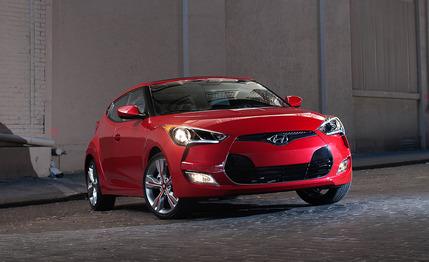
 Short Take Road Test
Short Take Road Test


Expectations are a bitch. If it weren’t for people’s pesky hopes, the 2012 Hyundai Veloster could totter onto the new-car market as a simple and oddly endearing little nugget of a dressed-up economy car.
But, no. On the back of this little three-door (four-door, if you count the hatch) meatball ride the hopes of enthusiasts who loved the old Honda CRX Si, who still love the Honda CRX Si, or who at least think they remember loving the CRX Si. And since Honda resolutely refuses to re-create one of its great ideas, the opportunity has fallen to the only car company that appears to have any interest in a similar concept: Hyundai.
Now, let’s get one thing straight: Hyundai never explicitly said that its four-seat Veloster was the spiritual replacement for the two-seat CRX Si. But given its size and shape, people have been drawing the comparison ever since the Veloster concept first appeared, and the company sure didn’t discourage the impression. Now that we’ve driven the production version over hill and dale, we can say, in our snappiest Lloyd Bentsen impersonation, that we worked with the CRX Si, we knew the CRX Si, the CRX Si was a friend of ours. Veloster, you’re no CRX Si.
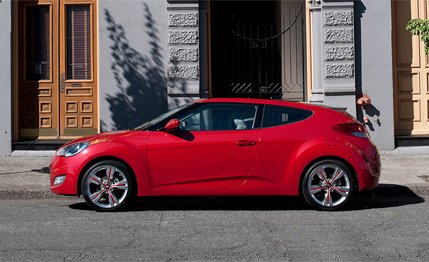

Is This Progress?
The 1985 CRX Si, pumping 91 hp from its 1.5-liter engine, could only get to 60 mph in 9.1 seconds. The Veloster’s 1.6-liter four-cylinder makes 138 hp, giving it a 0-to-60 run of, well, about half a second less slow than the CRX. And forget the CRX for a moment; the Veloster is taller and wider than Honda’s Accord of that era. The Veloster also rides on a longer wheelbase and weighs something like 300 more pounds than an ’85 Accord. It’s nearly 1000 pounds weightier than the CRX.


But it’s not door count or horsepower or weight that disqualifies the Veloster from second-coming-of-CRX status. It’s that the Veloster just isn’t that much fun to drive. It feels heavier than its roughly 2700-pound curb weight suggests. And its feel-free steering, although accurate, brings no joy. The steering happens to have the least amount of self-centering that we’ve felt in some time. After a turn, the wheel is apparently content to lie on its side, lifeless, instead of preparing for its next assignment.
That’s a shame, because the chassis it commands is competent. Maybe not spritely, but at least the MacPherson-strut-front and torsion-beam-rear suspension does an admirable job of snubbing roll without beating the driver senseless. The Veloster circled our skidpad at a mediocre 0.82 g. The Scion tC, which Hyundai lists as a Veloster competitor, returns 0.86 g of grip. It’s a nice middle-ground tuning that should satisfy those looking for an economy car wearing a snazzy outfit.
Smooth Out That Shar Pei
And snazzy it is. The front and the flanks mimic other recent Hyundais, most notably the Elantra. Its face is pulled back tightly, similar to what we imagine a dog would look like with an aggressive face lift. The Veloster’s sides are deeply sculpted. That’s all pretty much standard-issue new-Hyundai oddness, though. The real weirdness is the doors, or rather the asymmetry of the doors. We watched as a couple stopped dead in their tracks on seeing the Veloster sitting in a parking lot. The man approached it first from the driver’s side, cocked his head, shuffled closer, and peeked inside; then, without taking his eyes off the thing, he skirted around the Veloster’s chunky rear until he got to the passenger side. He stood staring for a moment and then squinted, thrust his head forward, and raised his eyebrows. He scooted back to the driver’s side, as if he believed that if he moved quickly enough he might surprise the driver’s side and catch it having two doors. No dice.
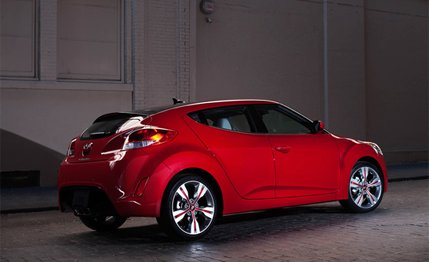

In its three-door-ness, the Veloster is like the Saturn coupe (SC) with the three-door option. Or the Mini Clubman, which also has a rear-hinged, door-opening extender added aft of a conventional door. But instead of a silly half-door, the Hyundai has a proper front-hinged rear door that is at least three-quarters as useful as a proper port. And not only can it be opened independently of the front door, but the Veloster’s rear door is also mounted to the passenger side instead of the driver’s.
This is useful for two reasons—one obvious and one we hadn’t anticipated. First, the passenger side is the curbside. So it is the safer of the two from which to disgorge rear passengers, which, given the Veloster’s tight rear quarters, are likely to be children or people you don’t like all that much. The other critical benefit of fitting the rear door to the passenger side is that it allows the driver’s door to be longer, keeping the B-pillar from impeding peripheral vision.
Gamma for Your Gramma
We only drove the Veloster with a six-speed manual, but it’s available with a new-for-Hyundai six-speed dual-clutch automatic. The shifter is perfectly pleasant to use, and the clutch takeup is smooth. But it’s not your left leg you’ll be worrying about. It’s your right leg that will be tired at the end of a drive, what with you trying to cram the accelerator through the floorboards. The so-called Gamma 1.6-liter direct-injection engine is a kindly enough motor, but it’s small and has low peak torque—123 lb-ft—at a high 4850 rpm. You have to work it over to make decent progress, and in our testing, the car needed 8.5 seconds to get to 60 mph. That’s more than 1.5 seconds slower to 60 mph than the Scion. The Veloster trundled through the quarter-mile in 16.7 seconds at 84 mph. A turbo is on the way within a year’s time.
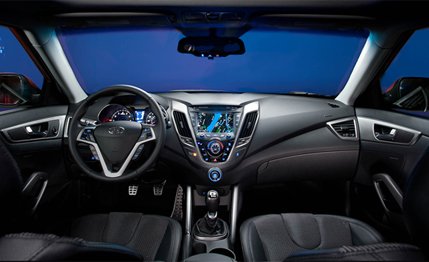

On the upside, when you’re not beating on the Veloster, the EPA reckons it will return 28 mpg in the city and 40 on the highway when equipped with the manual. With the dual-clutch tranny, the Veloster is predicted to return 29/38 mpg. In an attempt to keep things fun, our foot-to-the-floor driving style yielded a not-very-impressive 25 mpg average.
How To: Make Your Veloster Look Like the Concept
Perhaps we’ve been a bit tough on the Veloster. It starts at $18,060 for a manual version. The dual-clutch adds $1250. The example we drove came with both of the major option packages. The $2000 Style package mostly keeps the Veloster from looking like a cheap car. It brings 18-inch wheels, chrome trim, piano-black interior and exterior trim, front fog lights, an eight-speaker stereo, “leatherette” seats and door inserts, a leather-wrapped steering wheel and shift knob, aluminum pedals, and an auto-up driver’s window. But it’s the panoramic sunroof that comes with the Style package that gives the Veloster its signature look, with glass panels butted up against each other for an almost continuous sweep of glass from the base of the windshield all the way over the top of the roof and down to the rear bumper. It certainly makes the interior airy and is one of the more distinct similarities to the concept Veloster. But having one of the highest glass-to-metal ratios of any car on the market doesn’t do much for structural integrity.
The other available option grouping is the Tech package. It requires the Style package and then adds another $2000 of goodies like wheels with painted inserts intended to make them look like the Veloster concept’s. It also ropes in parking-distance sensors in the back, a rearview camera, a navigation system, automatic headlamps, and pushbutton start. Throw in floor mats ($95), and a loaded manual Veloster lists for $22,155.
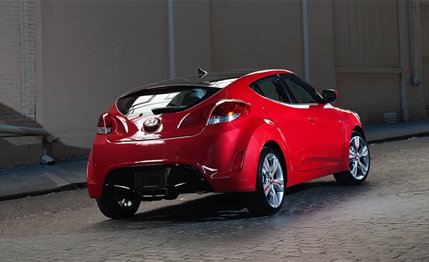

Hyundai gives this youth-oriented model standard Bluetooth with voice recognition, auxiliary and USB inputs, and the capability for video (or video-game) playback via an RCA cable. Furthermore, the car comes standard with Pandora internet-radio capability via iPhone. Not enough for you? How about a built-in video game that scores you on your eco-driving prowess? The CRX never had that, did it?